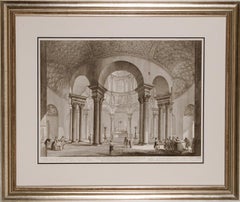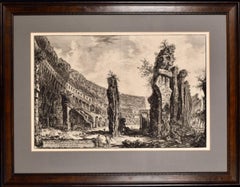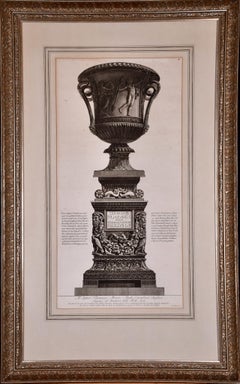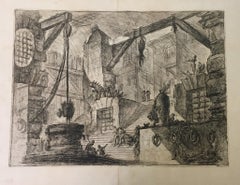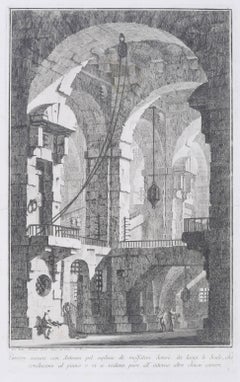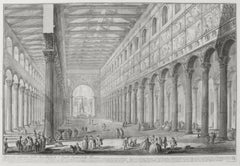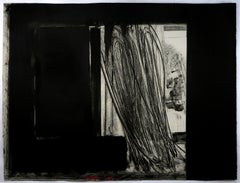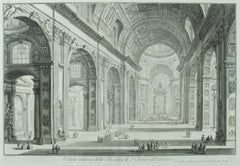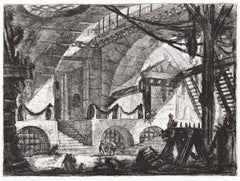Giovanni Battista Piranesi Interior Prints
Italian, 1720-1778
Piranesi was born in Venice in 1720 and died in Rome in 1778. He was the son of a stone mason and was trained as an architect. After a slow start he eventually achieved great success as an architect, archaeologist, artist, designer, collector, and antiquities dealer. His mission was to glorify the architecture of ancient Rome through his engravings and etchings. His highly dramatized prints often depict imaginary interiors and frequently include figures in mysterious activities, who are dwarfed by the magnitude of their monumental surroundings.
Piranesi's style greatly influenced the neoclassical art movement of the late 18th century. His dramatic scenes inspired generations of set designers, as well as artists, architects and writers. His prints have continued to increase in value to institutions and collectors.to
2
3
2
8
1
1
Overall Width
to
Overall Height
to
12
1
103
108
76
32
30
15
15
10
5
11
5
5
4
4
2
2
2
2
1
1
1
1
1
1
1
13
2
2
4
3
12
3
Artist: Giovanni Battista Piranesi
Church of St. Costanza, Rome: An 18th Century Piranesi Architectural Etching
By Giovanni Battista Piranesi
Located in Alamo, CA
This is a framed 18th century Giovanni Battista Piranesi etching entitled: "Veduta interna del Sepocro di Santa Costanza, fabbricat...
Category
1770s Old Masters Giovanni Battista Piranesi Interior Prints
Materials
Etching
The Roman Colosseum: A Framed 18th Century Etching of the Interior by Piranesi
By Giovanni Battista Piranesi
Located in Alamo, CA
This large framed 18th century etching by Giovanni Battista Piranesi entitled "Veduta dell'interno dell'Anfiteatro Flavio detto il Colosseo" (View of the interior of the Flavian Amph...
Category
1760s Old Masters Giovanni Battista Piranesi Interior Prints
Materials
Etching
A Framed 18th C. Piranesi Etching of an Ancient Marble Vase from Hadrian's Villa
By Giovanni Battista Piranesi
Located in Alamo, CA
This large framed 18th century etching by Giovanni Battista Piranesi is entitled "Vaso antico di Marmo adornato di eccellenti Sculture si nella parte anteriere che nell' opposta, le ...
Category
1770s Old Masters Giovanni Battista Piranesi Interior Prints
Materials
Etching
The Well, Carcere XIII - Etching by G.B.Piranesi - 1750s
By Giovanni Battista Piranesi
Located in Roma, IT
Giovanni Battista Piranesi, The Well, Carcere XIII , from “ Images of Prisons”, Buchard , Rome, 1749-50
Etching on laid paper. Signed on plate “ Piranesi F.” lower-right. Very good ...
Category
1750s Modern Giovanni Battista Piranesi Interior Prints
Materials
Etching
Carcere ascura
By Giovanni Battista Piranesi
Located in Fairlawn, OH
Carcere ascura
Etching, 1743
Signed in the plate bottom left corner
From: Prima Parte, 1743
Second edition: 1750-1778
Watermark: R 37-39
A lifetime impression printed during Piranesi’s life, before the plates are moved to Paris by his sons in the 1790’s
This image foretells Piranesi's famous set, Carceri (Prisons) which is his next creative effort.
Condition: Horizontal crease midway in the sheet associated with the manufacture of the paper.
Visible watermark verso
Small printer crease in the bottom right below the caption plate.
Image size: 14 1/2 x 9 1/2 inches
Reference: Robison 3 iii/VI
Piranesi In Rome: Prima Parte di Architetture e Prospettive
"Although Piranesi studied architecture in Venice, he never was able to find work in the field other than a few jobs involving remodeling in Rome. While Piranesi was struggling to support his architectural endeavors upon his arrival in Rome in 1740, he spent a short period of time in the studio of master painter Giovanni Battista Tiepolo (1696-1770) in addition to his apprenticeship with Giuseppe Vasi. The first production of Piranesi’s early years in Rome and a culmination of his training under Vasi, Tiepolo, and his uncle, was the Prima Parte di Architetture e Prospettive (1743). The Prima Parte was a collection of twelve etchings of imaginary temples, palaces, ruins, and a prison. During this time, Piranesi was still developing the unique style of etching he is known for today, and as such the Prima Parte differs significantly in technique compared to later works. In the Frontispiece of the Prima Parte, Piranesi’s lines are definite and exact with very little flow to them, designed in the form of traditional etching. The detail is immaculate, and yet perspective of the piece is oddly simple and familiar to the viewer. Piranesi’s technique employs miniscule markings and lines, intricately woven together to create a stippling effect. The Prima Parte, described as “rigid” by art historian Jonathan Scott, came to be seen as a stark contrast to his later sketches, which were much lighter and freer. Influenced by the style of Tiepolo, which epitomized the lightness and brightness of the Rococo period, Piranesi adopted some of the more painterly techniques of the masters he apprenticed under. Piranesi made the medium of etching appear as though it was a sketch or a painting, hence a “freer” and more fluid design in his later works. For example, the frontispiece of the Prima Parte read as an etching to Piranesi’s audience, but in his later vedute, the style of etching almost appears to be made of brushstrokes. Moreover, at the same time Piranesi was working on the Prima Parte, he aided the artist Giambattista Nolli. There is a small section of Nolli’s map...
Category
1740s Old Masters Giovanni Battista Piranesi Interior Prints
Materials
Etching
S. Paolo Fuori Le Mura (Vedute della Basilica di S. Paolo fuor della mura)
By Giovanni Battista Piranesi
Located in Fairlawn, OH
S. Paolo Fuori Le Mura (Vedute della Basilica di S. Paolo fuor della mura)
Etching, 1748
From: Vedute di Roma, Plate 8
An early Roman printing, published by Bouchard e Gravier
Watermark: Fleur de Lys in a double circle
Signed in the plate
Condition: Small margins as are common with Bouchard published impressions.
Centerfold (as usual)
Rich impression with good contrasts
Plate/Image size: 15 7/8 x 24 1/8 inches
Sheet size: 17 3/8 x 24 3/4 inches
Reference: Focillon 723
Wilton-Ely 138
Hind 6 ii/VI, Bouchard e Gravier printing, before the price and numbers in later states
This image is Piranesi’s second interior scene from the Vedute di Roma. The first interior is a less complex composition of the Interior of St. Peters which lacks the challenging perspective that the artist masters in this image.
The Papal Basilica of St. Paul Outside the Walls...
Category
1740s Old Masters Giovanni Battista Piranesi Interior Prints
Materials
Etching
The So-Called Tempio della Tosse, Near Tivoli. Interior Upright
By Giovanni Battista Piranesi
Located in Fairlawn, OH
The So-Called Tempio della Tosse, Near Tivoli. Interior Upright (Veduta interna del Tempio della Tosse)
"Temple of the Cough"
Etching, 1764
Signed in the plate
From: Vedute di Roma...
Category
1760s Old Masters Giovanni Battista Piranesi Interior Prints
Materials
Etching
Piranesi VI.
By Giovanni Battista Piranesi
Located in Slovak Republic, SK
Fine Art Print Hahnemuehle, edition, Giovanni Battista Piranesi print in Verlag von Ad Lehmann in Wien, end of 19 Century.
Category
Late 18th Century Italian School Giovanni Battista Piranesi Interior Prints
Materials
Black and White, Archival Pigment
$1,059 Sale Price
20% Off
Piranesi IV.
By Giovanni Battista Piranesi
Located in Slovak Republic, SK
Fine Art Print Hahnemuehle, editioned, Giovanni Battista Piranesi print in Verlag von AD Lehmann in Wien, end of the 19. century, SalamonArt certificate will be included.
Category
Late 18th Century Italian School Giovanni Battista Piranesi Interior Prints
Materials
Archival Pigment
$269 Sale Price
79% Off
18th Century Etching of Ancient Roman Architectural Objects by Giovanni Piranesi
By Giovanni Battista Piranesi
Located in Alamo, CA
A. Tigna Protensa Super Media Epistylia, B. Praecisiones Tigorum Quaqua Versus Extrinsectus Apparentium, C. Opae Extremitates Tigorum Contintes, Fig. I, plate 88 from "Vasi, Candelab...
Category
Mid-18th Century Old Masters Giovanni Battista Piranesi Interior Prints
Materials
Etching
The So-Called Tempio della Tosse, Near Tivoli. Interior Upright
By Giovanni Battista Piranesi
Located in Fairlawn, OH
The So-Called Tempio della Tosse, Near Tivoli. Interior Upright (Veduta interna del Tempio della Tosse)
"Temple of the Cough"
Etching, 1764
Signed in the plate
From: Vedute di Roma...
Category
1760s Old Masters Giovanni Battista Piranesi Interior Prints
Materials
Etching
Ancient Roman Medici Marble Vase: An 18th Century Etching by Piranesi
By Giovanni Battista Piranesi
Located in Alamo, CA
This large 18th century etching by Giovanni Battista Piranesi is entitled "Vaso antico di Marmo adornato di eccellenti Sculture si nella parte anteriere che nell' opposta, le quail r...
Category
1770s Old Masters Giovanni Battista Piranesi Interior Prints
Materials
Etching
Ancient Roman Marble Vase: 18th C. Piranesi Etching Vaso Cinerario di Gran Mole
By Giovanni Battista Piranesi
Located in Alamo, CA
"Vaso Cinerario di Gran Mole. Le Teste dei Giovenchi mostrano di reggere it pesante Festone composto di Frutti Fiori Grans ed use. Il tuto Necefsario all Vita Umana. Il Restante degl...
Category
1760s Old Masters Giovanni Battista Piranesi Interior Prints
Materials
Etching
Ruine di Sepolcro antico
By Giovanni Battista Piranesi
Located in Fairlawn, OH
Ruine di Sepolcro antico
Etching, 1743
Signed in the plate bottomleft in the caaption plate
From: Prima Parte, 1743
Second edition: 1750-1778
Watermark: R 37-39
A lifetime impression printed during Piranesi’s life, before the plates are moved to Paris by his sons in the 1790’s
Coniditon: Excellent/Very good
Image size: 14 5/8 x 9 3/4 inches
Reference: Robison 17 iii/V
Piranesi In Rome: Prima Parte di Architetture e Prospettive
"Although Piranesi studied architecture in Venice, he never was able to find work in the field other than a few jobs involving remodeling in Rome. While Piranesi was struggling to support his architectural endeavors upon his arrival in Rome in 1740, he spent a short period of time in the studio of master painter Giovanni Battista Tiepolo (1696-1770) in addition to his apprenticeship with Giuseppe Vasi. The first production of Piranesi’s early years in Rome and a culmination of his training under Vasi, Tiepolo, and his uncle, was the Prima Parte di Architetture e Prospettive (1743). The Prima Parte was a collection of twelve etchings of imaginary temples, palaces, ruins, and a prison. During this time, Piranesi was still developing the unique style of etching he is known for today, and as such the Prima Parte differs significantly in technique compared to later works. In the Frontispiece of the Prima Parte, Piranesi’s lines are definite and exact with very little flow to them, designed in the form of traditional etching. The detail is immaculate, and yet perspective of the piece is oddly simple and familiar to the viewer. Piranesi’s technique employs miniscule markings and lines, intricately woven together to create a stippling effect. The Prima Parte, described as “rigid” by art historian Jonathan Scott, came to be seen as a stark contrast to his later sketches, which were much lighter and freer. Influenced by the style of Tiepolo, which epitomized the lightness and brightness of the Rococo period, Piranesi adopted some of the more painterly techniques of the masters he apprenticed under. Piranesi made the medium of etching appear as though it was a sketch or a painting, hence a “freer” and more fluid design in his later works. For example, the frontispiece of the Prima Parte read as an etching to Piranesi’s audience, but in his later vedute, the style of etching almost appears to be made of brushstrokes. Moreover, at the same time Piranesi was working on the Prima Parte, he aided the artist Giambattista Nolli. There is a small section of Nolli’s map...
Category
1740s Old Masters Giovanni Battista Piranesi Interior Prints
Materials
Etching
Camera sepolcrale
By Giovanni Battista Piranesi
Located in Fairlawn, OH
Camera sepolcrale
Etching 1743
Signed in the bottom left corner
From: Prima Parte, 1743
Second edition: 1750-1778
Watermark: R 37-39
A lifetime impression printed during Piranesi’s life, before the plates are moved to Paris by his sons in the 1790’s
Condition: Excellent
Image size: 14 5/8 x 9 3/4 inches
Reference: Robison 20 iii/V
Piranesi In Rome: Prima Parte di Architetture e Prospettive
"Although Piranesi studied architecture in Venice, he never was able to find work in the field other than a few jobs involving remodeling in Rome. While Piranesi was struggling to support his architectural endeavors upon his arrival in Rome in 1740, he spent a short period of time in the studio of master painter Giovanni Battista Tiepolo (1696-1770) in addition to his apprenticeship with Giuseppe Vasi. The first production of Piranesi’s early years in Rome and a culmination of his training under Vasi, Tiepolo, and his uncle, was the Prima Parte di Architetture e Prospettive (1743). The Prima Parte was a collection of twelve etchings of imaginary temples, palaces, ruins, and a prison. During this time, Piranesi was still developing the unique style of etching he is known for today, and as such the Prima Parte differs significantly in technique compared to later works. In the Frontispiece of the Prima Parte, Piranesi’s lines are definite and exact with very little flow to them, designed in the form of traditional etching. The detail is immaculate, and yet perspective of the piece is oddly simple and familiar to the viewer. Piranesi’s technique employs miniscule markings and lines, intricately woven together to create a stippling effect. The Prima Parte, described as “rigid” by art historian Jonathan Scott, came to be seen as a stark contrast to his later sketches, which were much lighter and freer. Influenced by the style of Tiepolo, which epitomized the lightness and brightness of the Rococo period, Piranesi adopted some of the more painterly techniques of the masters he apprenticed under. Piranesi made the medium of etching appear as though it was a sketch or a painting, hence a “freer” and more fluid design in his later works. For example, the frontispiece of the Prima Parte read as an etching to Piranesi’s audience, but in his later vedute, the style of etching almost appears to be made of brushstrokes. Moreover, at the same time Piranesi was working on the Prima Parte, he aided the artist Giambattista Nolli. There is a small section of Nolli’s map...
Category
1740s Old Masters Giovanni Battista Piranesi Interior Prints
Materials
Etching
Related Items
Howard Hodgkin hand-colored Early Evening in the Museum of Modern Art
By Howard Hodgkin
Located in New York, NY
Large scale black and white abstract interior scene with dots, lines, brushstrokes, and hand painting in grey, to hang in contemporary, modern and minimalist spaces. While British pop artists such as David Hockney and Patrick Caulfield numbered amongst Howard Hodgkin's circle of friends, Hodgkin's work is painterly, emotional, expressionist, and abstract.
Early Evening in the Museum of Modern Art, by Howard Hodgkin. Signed by the artist, numbered, and dated 79 lower center in red crayon. Soft-ground etching printed from the same plate as 'Late Afternoon in the Museum of Modern Art', with hand coloring in black gouache on Grey BFK Rives mould-made paper.
This print depicts an abstracted scene, perhaps a sculpture in front of a window in the Museum of Modern Art, Oxford, in Hodgkin's signature painterly style. The expressive mark-making in this print is an example of the artist’s movement in the late 70s towards pronounced gestures. Wide areas of deep black pigment contrast urgent swipes of ink. Always seeking greater richness in his prints, Hodgkin layered ink and hand coloring in this print, rendering each impression in the edition unique.
Part of a series of four prints reflecting on a visit to...
Category
Late 20th Century Abstract Giovanni Battista Piranesi Interior Prints
Materials
Gouache, Etching
$2,250
H 29.5 in W 38.75 in
Bow Street Office: Rowlandson Hand-colored Engraving from Microcosm of London
By Thomas Rowlandson
Located in Alamo, CA
An early 19th century print entitled "Bow Street Office", an illustration (Plate 11) from "The Microcosm of London", published in London in 1808 by R. Acker...
Category
Early 1800s Other Art Style Giovanni Battista Piranesi Interior Prints
Materials
Aquatint, Etching
Thomas RowlandsonBow Street Office: Rowlandson Hand-colored Engraving from Microcosm of London, 1808
$655
H 18.5 in W 20 in D 0.88 in
Home David Hockney (Six Fairy Tales from the Brothers Grimm) Clandeboye House
By David Hockney
Located in New York, NY
From David Hockney’s celebrated Six Fairy Tales from the Brothers Grimm portfolio, an image from the story of ‘The boy who left home to learn fear’. Hockney chose this story for its ...
Category
1960s Modern Giovanni Battista Piranesi Interior Prints
Materials
Etching, Aquatint
$9,000
H 24.75 in W 17.75 in
'Jesus and the Woman at the Well, ' by Amand-Durand, Engraving
By Armand Durand
Located in Oklahoma City, OK
This early 19th century framed 35" x 31" engraving by artist Amand-Durand depcits an etching of 'Jesus and the Woman at the Well,' after the Dutch master, Rembrandt van Rijn. This poignant Biblical story is depicted by Arman-Durand in Rembrandt style...
Category
Early 19th Century Old Masters Giovanni Battista Piranesi Interior Prints
Materials
Engraving
$1,200 Sale Price
20% Off
H 30.5 in W 26.5 in D 1.5 in
William P. Hicks, Circus
Located in New York, NY
William P. Hicks has drawn everything about the circus that will fit in the plate. The main figure is an aerial act with a woman balancing on rope held by a figure on the floor. Ther...
Category
1930s American Modern Giovanni Battista Piranesi Interior Prints
Materials
Etching
Inside the castle by David Hockney (Six Fairy Tales from the Brothers Grimm)
By David Hockney
Located in New York, NY
From David Hockney’s celebrated Six Fairy Tales from the Brothers Grimm portfolio, an image of the story ‘The boy who left home to learn fear’. Hockney chose this story for its obscu...
Category
1960s Modern Giovanni Battista Piranesi Interior Prints
Materials
Etching, Aquatint
$2,250
H 17.75 in W 16 in
Original AJANTA INDIA Bodhisattva Padmapani vintage travel poster 1959
Located in Spokane, WA
Original Ajanta India vintage travel poster from 1959. Archival linen backed in Grade A condition, ready to frame. Note that a later edition of this poster was printed but the im...
Category
1950s Old Masters Giovanni Battista Piranesi Interior Prints
Materials
Lithograph
$995
H 39.5 in W 24.25 in D 0.3 in
Room for One More (New York City Subway)
By Irving Guyer
Located in New York, NY
This Depression-era New York City subway scene says it all. The body language of all five passengers tells us where each of them is in his or her ...
Category
1930s Ashcan School Giovanni Battista Piranesi Interior Prints
Materials
Etching, Aquatint
Peter Doig, Fisherman (from Black Palms) - 2004, Etching, Signed Print
By Peter Doig
Located in Hamburg, DE
Peter Doig (born 1959 in Edinburgh)
Fisherman, 2004
Series: From the “Black Palms” portfolio
Medium: Etching in colors, on 250g/qm Zerkall paper
Medium: 53.5 × 38 cm (21 1/10 × 15 in...
Category
21st Century and Contemporary Contemporary Giovanni Battista Piranesi Interior Prints
Materials
Etching
$4,214
H 21.07 in W 14.97 in
Jewish Shtetl Shabbat Candles Russian Judaica Etching w Hand Watercolor Painting
By Eugene Abeshaus
Located in Surfside, FL
EUGENE ABESHAUS Leningrad, Russia, (1939-2008)
Hand-Colored, with watercolor painting, Etching hand signed in pencil in English and Hebrew
Numbered 47/110
Framed 21.5 x 16. image 13.5 x 9
Eugene Abeshaus (also spelled Evgeny Abezgauz, Евгений Абезгауз in Russian; 1939–2008) was a Jewish artist who worked in Russia (then USSR) and Israel.
Born in Leningrad to a typical intelligentsia family, Abeshaus was educated as an electrical engineer but soon abandoned this career and enrolled in the Mukhina School for Applied Art. By the time of his graduation from the famous “Mukha” (Fly in Russian), he had already developed a critical stance towards the official Soviet art dominated by the Communist ideology and began exhibiting at semi-underground exhibitions. This was culminated by his taking part in a famous 1975 exhibition at the Nevsky Palace of Culture. Abeshaus was fired from his job and censured by the official press – which however admitted his "artistic taste, a good sense of color and form".
Soon afterwards, Abeshaus set up, together with several Jewish artists, the Alef Group and became its leader. The group’s first exhibition in November 1975 was held at Abeshauses’ small apartment. According to the Alef Manifesto written by Alek Rapoport, “We are trying to conquer the influence of small-town Jewish art and find sources for our work in deeper, wiser, and more spiritual European culture, and from it build a bridge to today and tomorrow". He was part of a generation of Russian, mostly Jewish artist's that included Oskar Rabin, Evgeny Rukhin...
Category
20th Century Modern Giovanni Battista Piranesi Interior Prints
Materials
Watercolor, Etching, Paper
Knackers
By William Strang, R.A., R.E.
Located in New Orleans, LA
Binyon 232 - A fine impression in fine condition in an edition of 55 signed and inscribed by the artist.
Strang was a prolific printmaker and across his lifetime produced over 750 o...
Category
1890s Modern Giovanni Battista Piranesi Interior Prints
Materials
Etching
18th Century Etching of Ancient Roman Architectural Objects by Giovanni Piranesi
By Giovanni Battista Piranesi
Located in Alamo, CA
A. Tigna Protensa Super Media Epistylia, B. Praecisiones Tigorum Quaqua Versus Extrinsectus Apparentium, C. Opae Extremitates Tigorum Contintes, Fig. I, plate 88 from "Vasi, Candelab...
Category
Mid-18th Century Old Masters Giovanni Battista Piranesi Interior Prints
Materials
Etching
$1,975
H 25.63 in W 19.13 in D 1.25 in
Previously Available Items
St. Peter's Interior with the Nave
By Giovanni Battista Piranesi
Located in Fairlawn, OH
St. Peter's Interior with the Nave
Veduta interna della Basilica di S. Pietro in Vaticano
Etching, 1748
Signed in the plate
From: Vedute di Roma, Plate 5
An early Roman...
Category
1740s Old Masters Giovanni Battista Piranesi Interior Prints
Materials
Etching
The Sawhorse
By Giovanni Battista Piranesi
Located in New York, NY
A superb, dark, richly-inked impression of this etching, engraving and open-bite. Fourth state (of 6); Robison's second edition, second through third issues, printed from the early 1...
Category
1740s Italian School Giovanni Battista Piranesi Interior Prints
Materials
Engraving, Etching
A Framed 18th C. Piranesi Etching of an Ancient Marble Vase
By Giovanni Battista Piranesi
Located in Alamo, CA
This large framed 18th century etching by Giovanni Battista Piranesi entitled "Veduta in Prospettiva per angolo di un Vaso antico di Marmo con suo Piedestallo" (Perspective view by corner of an ancient marble...
Category
1770s Old Masters Giovanni Battista Piranesi Interior Prints
Materials
Etching
H 41.25 in W 31.38 in D 1.5 in
Piranesi V.
By Giovanni Battista Piranesi
Located in Slovak Republic, SK
Fine Art print Hahnemuehle, edition, Giovanni Battista Piranesi print in Verlag von AD Lehmann in Wien, end of 19. Century. SalamonArt certificate will be included.
Category
Late 18th Century Italian School Giovanni Battista Piranesi Interior Prints
Materials
Archival Pigment
Pair of Piranesi Etchings of Ancient Roman Architectural Objects, 18th Century
By Giovanni Battista Piranesi
Located in Alamo, CA
A pair of etchings created by Giovanni Piranesi depicting Roman architectural details from his "Le Antichità Romane" (Ancient Rome) published in 1756. The first print is entitled "Pr...
Category
Mid-18th Century Old Masters Giovanni Battista Piranesi Interior Prints
Materials
Etching
Spaccato Interno della Basilica di S. Paolo fuori della Mura” Etching,
By Giovanni Battista Piranesi
Located in San Francisco, CA
This mid-18th century etching by Giovanni Battista (Giambattista) Piranesi (b. 1720-1778) is titled “Spaccato Interno della Basilica di S. Paolo fuori della Mura” (“Cutaway view of the Interior of the Basilica of San Paolo fuori delle Mura”. It is from his most important and famous series, “Vedute di Roma” , the artist’s historically important series of 135 etchings documenting views of ancient and then-contemporary Rome, published from 1745 onward. This work was first published in 1749. This is the 3rd state of 7 published states. In the Hind reference, this is Hind 7/iii. This particular etching is on a thick laid paper with the watermark of a fleurs de lys enclosed by two circles, with a smaller circle above in which is an indistinguishable letter, perhaps a B. This etching is in good condition and a nice crisp image because it is an early state. It is not trimmed, framed, mounted or laid down. There is a ¼” tear along the lower edge. There are a number of slightly thinned areas along all edges, but because the print is on such a thick laid paper, there is very good density and integrity even in the slightly thinned areas on the edges. The center crease, present in all of the Vedute di Roma works is almost invisible; one must look very closely at the horizontal rafters on the top of the print to almost make out the crease. The print measures 16 1/2 x 24 1/8 in. (sheet 18 ¾” in x 26 1/2 in.)
The interior of the basilica of Saint Paul outside the walls shows its frescoes, papal portraits, and imperial Roman marble...
Category
1740s Realist Giovanni Battista Piranesi Interior Prints
Materials
Etching
H 18.5 in W 26.75 in D 0.1 in
Interior view of the Church of San Stefano Rotondo
By Giovanni Battista Piranesi
Located in New York, NY
Giovanni Battista Piranesi (1720-1778), Veduta dell’interno del Tempio di S. Stefano Rotondo (Interior view of the Church of San Stefano Rotondo), etching, 1756. First Edition, from the series Le Antichita Romane, Bouchard e Gravier 1756, section XXV, figure 2 [signed, numbered and titled in the plate]. References: Focillon 192, Wilton-Ely 327. In good condition, with margins, 5 1/2 x 8, the sheet 6 1/4 x 9 inches.
A very good impression, printed on a stiff cream laid paper.
Piranesi developed the plates of the Antichita Romane (Roman Antiquities) after eight...
Category
1750s Old Masters Giovanni Battista Piranesi Interior Prints
Materials
Etching
Giovanni Battista Piranesi interior prints for sale on 1stDibs.
Find a wide variety of authentic Giovanni Battista Piranesi interior prints available for sale on 1stDibs. You can also browse by medium to find art by Giovanni Battista Piranesi in etching, archival pigment print, engraving and more. Much of the original work by this artist or collective was created during the 18th century and is mostly associated with the Old Masters style. Not every interior allows for large Giovanni Battista Piranesi interior prints, so small editions measuring 15 inches across are available. Customers who are interested in this artist might also find the work of and Rembrandt van Rijn. Giovanni Battista Piranesi interior prints prices can differ depending upon medium, time period and other attributes. On 1stDibs, the price for these items starts at $979 and tops out at $24,955, while the average work can sell for $2,625.
Questions About Giovanni Battista Piranesi Interior Prints
- 1stDibs ExpertJanuary 10, 2025Giovanni Battista Piranesi is famous for his work spanning many different fields. After a slow start, he eventually achieved great success as an architect, archaeologist, artist, designer, collector and antiquities dealer. His mission was to glorify the architecture of ancient Rome through his engravings and etchings. His highly dramatized prints often depict imaginary interiors and frequently include figures in mysterious activities who are dwarfed by the magnitude of their monumental surroundings. Piranesi's style greatly influenced the neoclassical art movement of the late 18th century. Explore a collection of Giovanni Battista Piranesi art on 1stDibs.
